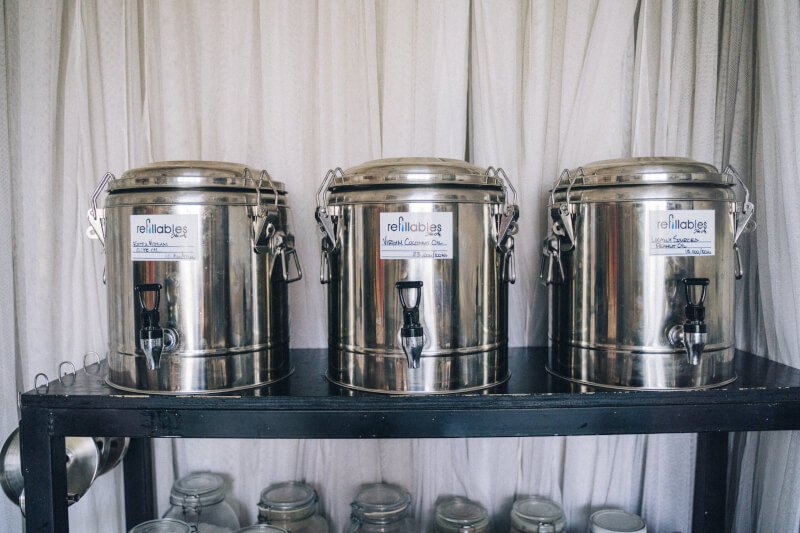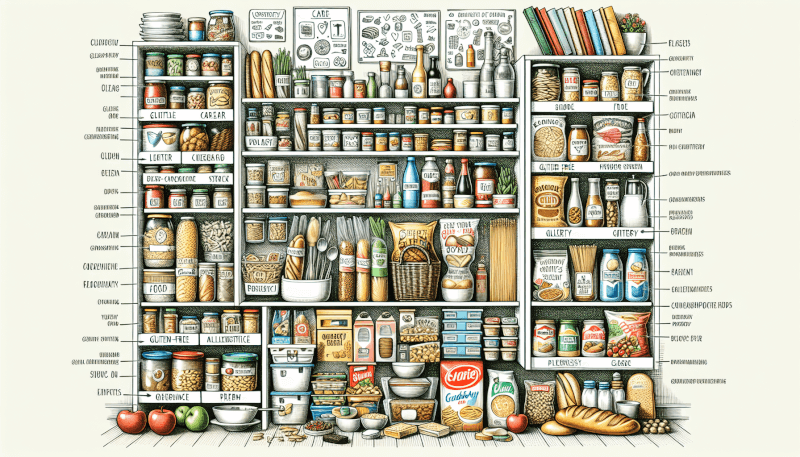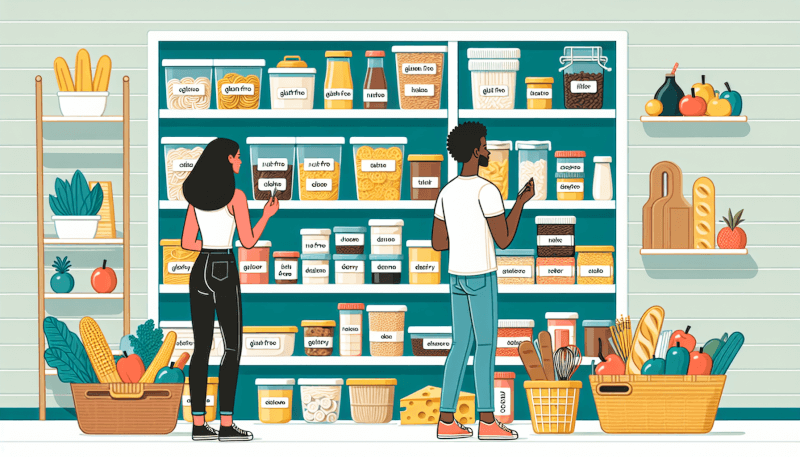Are you following a gluten-free or allergy-friendly diet? If so, then you know the importance of having safe and reliable food storage options. In this article, we explore different methods and containers for storing your gluten-free and allergy-friendly foods, ensuring that they stay fresh and uncontaminated. From glass jars to airtight containers, we’ve got you covered with tips and recommendations for maintaining the integrity of your specialized dietary needs. So whether you’re a seasoned pro or just starting out on your journey, read on to discover the best practices for food storage that will keep your meals safe and delicious.
Understanding gluten-free and allergy-friendly diets
What is a gluten-free diet?
A gluten-free diet is a dietary plan that excludes the protein gluten, which is found in grains such as wheat, barley, and rye. This diet is essential for individuals with celiac disease, a gluten-related autoimmune disorder, as well as those with gluten sensitivity. By eliminating gluten from your diet, you can alleviate symptoms such as digestive issues, skin problems, and fatigue.
What are common allergies and intolerances?
Apart from gluten sensitivities, there are numerous other allergies and intolerances that individuals may have. Common allergens include peanuts, tree nuts, dairy, eggs, soy, fish, and shellfish. Lactose intolerance, also prevalent, is the inability to fully digest lactose, the sugar found in milk and dairy products. Allergies and intolerances can vary in severity, with some individuals experiencing mild reactions and others facing life-threatening anaphylaxis.
Benefits of gluten-free and allergy-friendly diets
Adopting a gluten-free and allergy-friendly diet can provide numerous benefits to individuals who have allergies or intolerances. Firstly, it helps to manage symptoms and prevent adverse reactions. By avoiding allergens and gluten, you can effectively control digestive issues, rashes, respiratory problems, and other symptoms associated with these dietary restrictions. Additionally, a gluten-free and allergy-friendly diet promotes a healthier lifestyle overall by encouraging the consumption of whole, unprocessed foods. This can lead to improved gut health, increased energy levels, and weight management.
Choosing allergy-friendly and gluten-free products
Reading labels and ingredients
When selecting products for a gluten-free or allergy-friendly diet, it is crucial to carefully read labels and understand ingredients. Look for products that explicitly state they are gluten-free or free from specific allergens. Pay attention to warning labels such as “may contain,” as these indicate possible cross-contamination. Familiarize yourself with hidden sources of allergens, as they may appear under different names in ingredient lists. Educating yourself on ingredients is essential to ensure the safety of your diet.
Certifications and labels to look for
To make the process of selecting allergy-friendly and gluten-free products easier, look for specific certifications and labels that indicate the product meets certain standards. One common certification to look for is the Gluten-Free Certification Organization (GFCO) label, which ensures that the product has been tested and meets the required gluten-free standards. Other notable certifications include the Food Allergy Research & Education (FARE) label, which indicates the product is free from specific allergens, and the Non-GMO Project Verified label, which certifies that the product does not contain genetically modified organisms.
Avoiding cross-contamination
Cross-contamination can be a significant concern when storing and preparing food for individuals with allergies or gluten intolerance. To avoid cross-contamination, it is essential to keep allergenic and gluten-containing products separate. Use dedicated utensils, cutting boards, and cooking equipment for allergy-friendly and gluten-free items. Clean kitchen surfaces, utensils, and equipment thoroughly to eliminate any traces of allergens. By taking these precautions, you can reduce the risk of accidental exposure to allergens.

Proper food storage techniques
Storing gluten-free grains and flours
Gluten-free grains and flours, such as rice, quinoa, almond flour, and oat flour, should be stored in airtight containers to prevent moisture and insect contamination. It is advisable to transfer these items to clear containers, as this allows for easy visibility and prevents confusion with gluten-containing counterparts. Store gluten-free grains and flours in a cool, dry place, such as a pantry or cupboard, to maintain their freshness and prevent spoilage.
Keeping allergy-friendly pantry staples fresh
Pantry staples for allergy-friendly diets, such as nut butters, seeds, and gluten-free baking mixes, should also be stored in airtight containers. These containers help maintain freshness and prevent exposure to air, which can cause oxidation and loss of flavor. It is recommended to store these pantry staples in a cool and dark place away from direct sunlight and heat sources. Regularly check the expiration dates of these items and make sure to rotate them to use older products first.
Freezing and refrigerating perishable items
For perishable items that need to be stored for an extended period, such as allergy-friendly bread, dairy alternatives, or prepared meals, freezing or refrigerating is the best option. To freeze perishable items, ensure they are tightly wrapped in moisture-resistant packaging, such as freezer bags or containers. Label each item with the date of freezing to keep track of freshness. In the refrigerator, store perishable items in designated areas to prevent cross-contamination and ensure they are consumed within their recommended shelf life.
Organizing and arranging your pantry
Separating gluten-free and allergy-friendly items
When organizing your pantry for gluten-free and allergy-friendly diets, it is crucial to separate gluten-free items from those containing gluten, as well as allergenic products. This prevents accidental cross-contamination and makes it easier to locate specific items when preparing meals. Designate separate shelves or areas of your pantry for each category of food and clearly label them to ensure everyone in the household knows where to find or store items correctly.
Using clear containers and labels
Using clear containers for storing dry goods and pantry staples is highly recommended. Clear containers allow for easy visibility and help you quickly identify the items you need. Additionally, labeling each container with the product name and expiration date ensures that you can easily keep track of freshness and prevent wastage.
Creating zones for different food groups
Creating zones within your pantry for different food groups aids in maintaining an organized and allergen-free storage system. For example, you can have separate zones for gluten-free grains, allergy-friendly baking supplies, and canned goods. This division makes it easier to locate items and prevents accidental exposure to allergens. Consider using color-coded labels or dividers to visually differentiate the zones and enhance organization.

Maintaining a clean and allergen-free kitchen
Regularly cleaning kitchen surfaces and utensils
Maintaining a clean kitchen is essential for individuals with allergies or gluten intolerance. Regularly clean kitchen surfaces, such as countertops, cutting boards, and sink areas, to avoid cross-contamination. Use hot, soapy water or designated allergen-friendly cleaning products to eliminate any traces of allergens.
Avoiding cross-contamination during food preparation
When preparing meals, take precautions to avoid cross-contamination. Use separate cutting boards, utensils, and cookware for allergenic and gluten-containing ingredients. Ensure thorough cleaning between each use to prevent the transfer of allergens. It is also essential to wash your hands thoroughly before and after handling allergenic products or gluten.
Using dedicated cutting boards and utensils
Utilize dedicated cutting boards and utensils specifically for allergy-friendly and gluten-free food preparation. Keep these items separate from those used for allergenic ingredients to prevent cross-contamination. For individuals with severe allergies, it may be necessary to have designated cutting boards and utensils that are exclusively used for their specific allergen.
Food storage tips for specific allergens
Peanut and tree nut allergies
For individuals with peanut and tree nut allergies, it is crucial to store nut-free alternatives separately from products that contain nuts. Use clear containers and labels to differentiate these items and prevent confusion. When preparing meals, thoroughly clean and sanitize utensils and work surfaces to eliminate any traces of peanuts or tree nuts.
Dairy and lactose intolerance
To prevent exposure to dairy products for individuals with lactose intolerance or dairy allergies, store alternative dairy products separately from dairy-based items. Use clear containers and labels for identification. Consider using lactose-free or plant-based milk, cheese, and yogurt as substitutes. Proper cleaning and sanitizing of utensils and equipment after use are essential.
Egg allergies
For those with egg allergies, store egg-free alternatives separately from products containing eggs. Use clear containers and labels to distinguish between the two. When cooking, be cautious of ingredients that may contain hidden sources of eggs, such as baked goods, pasta, and sauces. Always read labels to ensure egg-free options are used.
Soy allergies
Individuals with soy allergies should store soy-free alternatives separately from products containing soy. Look for soy-free alternatives for common soy-based products like soy sauce, tofu, and soy milk. Use clear containers and labels to prevent confusion. Check labels carefully, as soy can be present in unexpected food items, such as baked goods, processed meats, and condiments.
Fish and shellfish allergies
For individuals with fish and shellfish allergies, it is crucial to avoid cross-contamination and separate fish and shellfish from other food products. When storing seafood, wrap it tightly in moisture-resistant packaging and store it separately from other items. Use clear containers and labels to ensure easy identification and prevent accidental exposure.

Long-term storage options for emergency preparedness
Stocking up on allergy-friendly and gluten-free canned goods
For emergency preparedness, it is prudent to stock up on allergy-friendly and gluten-free canned goods. Canned fruits, vegetables, legumes, and meats can provide essential nutrients and sustenance during emergencies. Check the labels of canned goods to ensure they are free from allergens and gluten. Rotate your stock periodically to ensure freshness and maintain a ready supply.
Storing dehydrated and freeze-dried meals
Dehydrated and freeze-dried meals are excellent options for long-term storage. These meals are lightweight, compact, and have a long shelf life. Look for allergy-friendly and gluten-free options, as many brands cater to specific dietary needs. Store these meals in a cool, dry place, away from direct sunlight or extreme temperatures, to maintain their quality.
Creating a food storage plan
To ensure you are adequately prepared for emergencies, create a food storage plan that includes allergy-friendly and gluten-free options. Consider the number of individuals in your household and their dietary restrictions when planning quantities. Rotate your stock regularly to consume and replace items before they expire. Additionally, keep a supply of essential non-perishable items such as water, medications, and personal hygiene products.
Preventing cross-contamination when storing and preparing food
Tips for storing bulk items
When storing bulk items, such as grains, legumes, and baking supplies, it is essential to prevent cross-contamination. Store these items in airtight containers and separate them from allergenic and gluten-containing products. Keep them in designated areas, ideally on higher shelves, to prevent accidental spills or contamination.
Properly cleaning reusable containers
Reusable containers, such as food storage containers and water bottles, should be thoroughly cleaned between uses. Use hot, soapy water or dishwasher-safe containers to ensure they are free from allergens and bacteria. Pay extra attention to lids, caps, and sealing mechanisms, as they can harbor residue. Allow containers to dry completely before reusing or storing to prevent the growth of mold or bacteria.
Separating utensils and equipment
To prevent cross-contamination, it is crucial to separate utensils and equipment used for allergenic ingredients or gluten-containing foods. Designate specific utensils, mixing bowls, and cooking equipment for allergy-friendly and gluten-free preparations. Store these items separately and ensure they are thoroughly cleaned and sanitized after each use.

Meal planning and batch cooking for easy access to safe food
Creating a weekly meal plan
Meal planning is a highly effective strategy to ensure easy access to safe and allergy-friendly meals. Take into account your dietary restrictions and plan meals accordingly. Choose recipes that use common allergen-free ingredients and rotate them to add variety. A weekly meal plan helps streamline grocery shopping and eliminates the need to constantly decide what to cook, which can be challenging when dealing with dietary restrictions.
Batch cooking and freezing individual portions
Batch cooking is a time-saving technique that allows you to prepare larger quantities of meals at once. Cook allergy-friendly and gluten-free meals in bulk and portion them into individual servings. Freeze these portions in airtight containers or freezer bags, ensuring proper labeling with the meal name and date. This method saves time, reduces the risk of cross-contamination during meal preparation, and provides convenient access to safe food options.
Using meal prep containers for convenient storage
Investing in meal prep containers can greatly simplify the process of storing and accessing prepared meals. These containers are specifically designed with divided compartments, allowing you to portion different components of a meal while keeping them separate. They are also stackable and easily transportable, making them ideal for taking meals to work or school.
Avoiding food spoilage and waste
Properly storing leftovers
When dealing with leftovers, it is crucial to store them properly to avoid food spoilage and waste. Allow the food to cool before transferring it to airtight containers or refrigerating. Label containers with the date of preparation to help monitor freshness. Consume leftovers within three to four days or freeze them for longer storage. Dispose of any leftovers that show signs of spoilage, such as bad odor, mold, or a change in texture.
Monitoring expiration dates
Regularly check the expiration dates of all packaged and perishable food items. This practice helps ensure that you consume them before they expire and maintain their quality. Implement a first-in, first-out system when organizing your pantry, fridge, and freezer. Use older items first before opening newer ones to reduce the chance of forgotten or wasted food.
Using FIFO (First-In, First-Out) system
The first-in, first-out (FIFO) system involves organizing your food storage in a way that prioritizes using older products before newer ones. This system helps prevent the accumulation of expired or wasted food items. When purchasing or restocking food, place newer items behind older ones in your pantry and fridge, ensuring you consume the older items first. This way, you can maximize the freshness and usability of your food while minimizing waste.
By understanding gluten-free and allergy-friendly diets, choosing appropriate products, implementing proper storage techniques, maintaining a clean kitchen, and practicing safe food handling, individuals can enjoy a safe and healthy lifestyle while managing their dietary restrictions. With careful planning, organization, and storage, individuals can navigate their food storage needs, avoid cross-contamination, and ensure easy access to safe and allergen-free meals.



